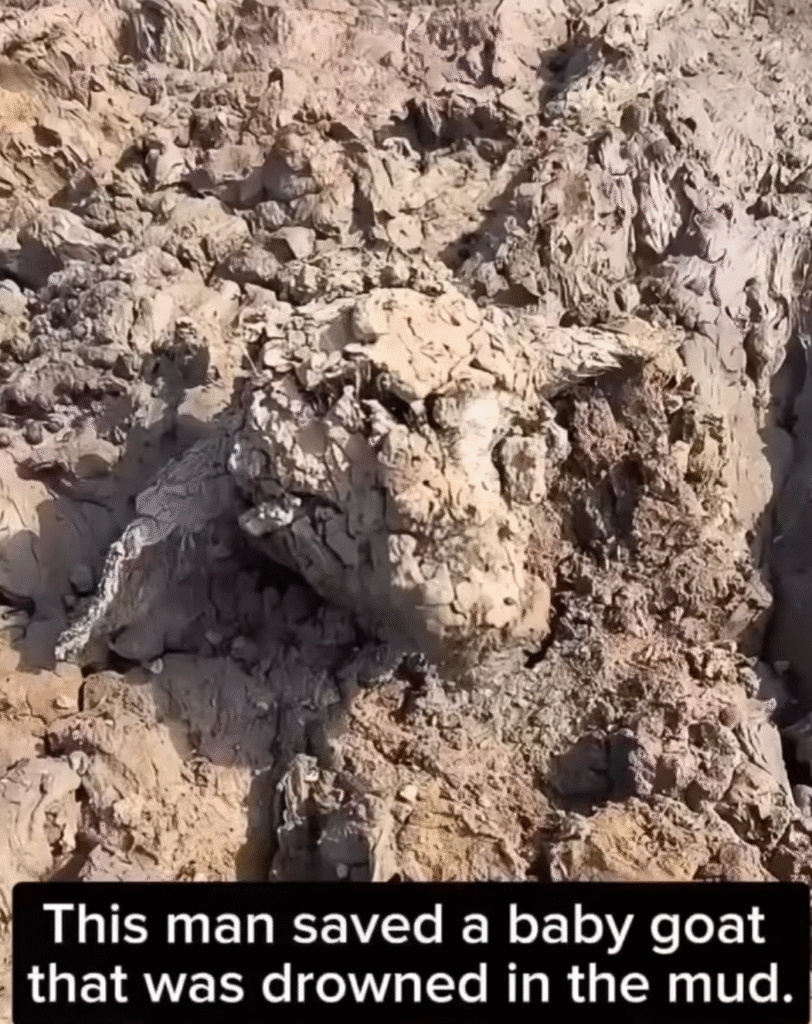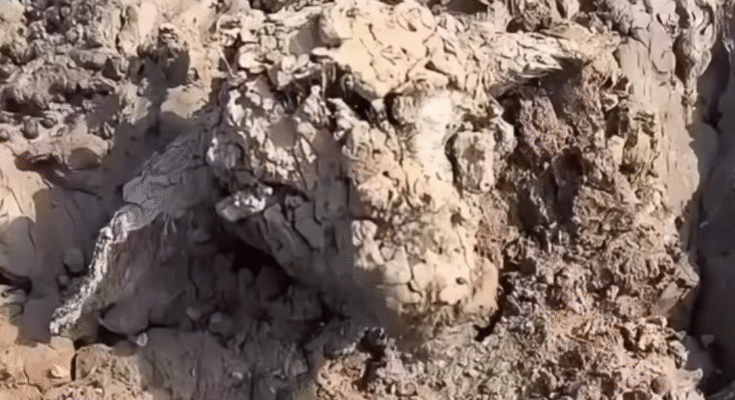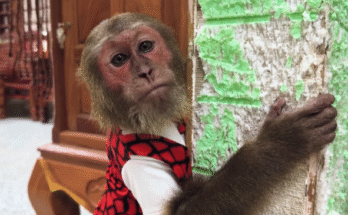It was a quiet afternoon on the farm when we first heard the faint cry — a high-pitched bleat, barely audible above the rustling wind and chirping birds. At first, we thought it was just one of the neighbor’s goats calling out, but then we heard it again, this time more desperate and strained. Something wasn’t right.
Curious and concerned, I motioned to my younger brother, Jake, and we grabbed our boots and headed toward the sound, weaving through tall grass and prickly shrubs on the far side of our property. As we rounded the hill near the edge of the forest, we spotted movement near a clump of rocks. It was there we found him — a tiny baby goat, no more than a few weeks old, lying awkwardly on his side with one leg caught in a tangle of brambles. His fur was matted with mud, and his eyes were wide with panic and exhaustion.
Jake crouched down immediately. “He’s hurt,” he said softly, gently prying the thorns from the baby goat’s leg. The kid flinched but didn’t struggle. He was too weak. It was heartbreaking.
We didn’t know where he had come from. There were no other goats nearby, no sign of a mother or herd. He had likely gotten separated and wandered too far, only to get trapped and left alone, hungry and vulnerable. Without thinking twice, we wrapped him in Jake’s flannel shirt and carried him back to our barn.

A Fragile Beginning
The first 48 hours were touch-and-go. We made a soft bed of hay for him in the warmest corner of the barn and brought him warm milk in a bottle every few hours. At first, he was too weak to drink much. We had to be patient, coaxing him to sip a little at a time.
Our vet, Dr. Lynn, came out to check on him. She said he was malnourished, dehydrated, and likely traumatized. But she also saw a spark of life in his eyes — a stubborn will to survive.
“I’ve seen worse,” she said with a smile. “Give him love, warmth, and time. He might just make it.”
We named him Lucky.
Bonding and Recovery
Over the next week, Lucky began to show signs of improvement. He started taking more milk, even wagging his little tail when he saw us coming with the bottle. His limp leg slowly healed, and his energy returned bit by bit. By the end of the second week, he was up on his feet, wobbling around the barn like a newborn fawn, bleating cheerfully for attention.
What surprised us most was how attached he became to us. Unlike the other goats we’d raised over the years, Lucky followed us everywhere — into the chicken coop, around the garden, even up to the porch. If we left his sight, he’d bleat until one of us returned.
Jake built a small playpen outside the barn just for him, with logs to climb and rubber toys to chew on. Lucky loved it. But more than anything, he loved being with us. He especially bonded with my brother — curling up next to him during storytime and nuzzling his face with a little “meh” whenever Jake sat down.
Introducing Lucky to the Herd
Eventually, it was time to introduce Lucky to the rest of our goats. We were a bit nervous — goats can be territorial, and our older billy, Rufus, had a reputation for being grumpy. But the introduction went smoother than expected.
Lucky approached the herd with caution, ears perked and tail flicking. The does were curious and gently sniffed him. Rufus gave one low bleat and strutted around, but Lucky held his ground. To our amazement, Rufus finally gave a small nod and walked away, as if to say, “You’ll do.”
Within days, Lucky was part of the group — playing, climbing, and butting heads like he’d always belonged. Yet, even with his new goat family, he still ran to us when he saw us, clearly knowing who had saved him.
A Part of the Family
Seasons passed. Lucky grew bigger, stronger, and bolder. His once-fragile body was now sturdy and sleek, with shiny white fur and confident eyes. But he never lost his sweet nature.
Every morning, without fail, Lucky would be waiting at the gate when we came out. He loved to “help” with chores — nibbling on the laundry as we hung it up, knocking over baskets, or just watching us work with calm eyes and the occasional “meh” of approval.
He became a local celebrity. Neighbors would visit just to see him. Kids from the nearby school would come on field trips and giggle when Lucky gently nuzzled their backpacks. Even Dr. Lynn would often stop by just to see how “her miracle patient” was doing.
Full Circle
One spring morning, something beautiful happened. One of our older does, Bella, gave birth to twins — a little boy and girl. But shortly after, she rejected the boy for reasons we couldn’t understand. He was left cold and crying.
Before we could step in, Lucky did something that brought tears to our eyes. He nudged the tiny newborn gently, then lay down beside him, curling his body around the baby like a blanket. The little one stopped crying and slowly drifted off to sleep.
Lucky became the baby’s protector, just as we had been his. It was a full-circle moment — the rescued now rescuing.
The Heart of Our Farm
Lucky is more than just a goat to us now. He’s a symbol of hope, of resilience, of the bond that forms when compassion meets determination. He reminds us that every life matters, no matter how small or fragile. His story has touched everyone who hears it, and he’s become the heart of our farm.
On quiet nights, when the sun sets over the hills and the animals settle in, Lucky still finds his way to our porch. He’ll sit beside us as we sip tea, his head resting on Jake’s knee, eyes half-closed with contentment.
We didn’t just save Lucky that day — he saved something in us, too. A reminder that love, when given freely, can transform even the most desperate moments into something beautiful.
Lucky was once a baby on the brink. Now, he’s family.



